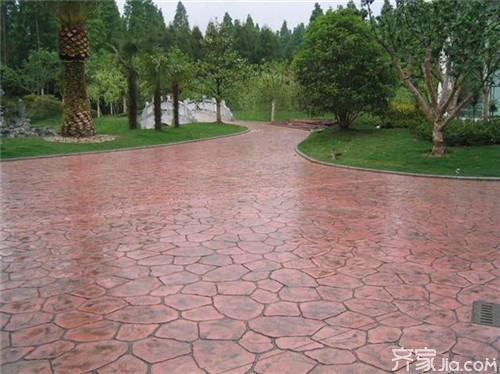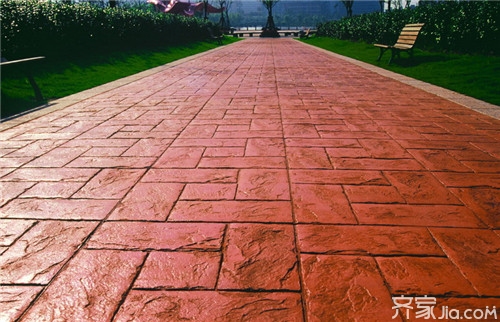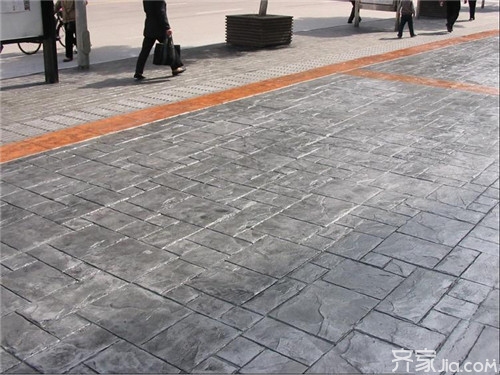The imprinting floor is applied to the roads of various places in the north and south of the river. Different customers and different manufacturers have different names. The general name is: the stamping floor, the embossed floor, the stamping floor, Embossed roads, embossed roads, embossed concrete, concrete stampers, road embossing, road embossing, and more. According to the different textures, we have a lot of names, but they can be roughly divided into three categories: First, imitation stone road imprinting second, imitation brick road imprinting third, imitation wood road imprinting . Then the following will introduce color stamping floor construction process and maintenance requirements.

Impression floor overview
The imprinting floor is a very realistic simulation of the texture and color of many high-end building decoration materials on the surface of concrete. It has changed the gloomy and indifferent appearance of the concrete surface, showing the effect resembling that of natural granite, marble, volcanic rock, bluestone, wood and brick. Stone and so on; it can deliberately show the rough texture of natural materials, bumpy and complex textures, can also be smooth as water, bright as a mirror, infinite color combinations and mold choices allow the designer's imagination to be free to ride.
The product is characterized by being able to imitate the texture and color of many high-end building decoration materials directly on the concrete, showing the effect resembling the natural quartzite, wood board, volcanic rock and so on. It can deliberately show the rough texture of natural materials, uneven and complex texture, the overall shape, one-time pavement, quick construction, while at the same time to solve the general color of the poor color brick, uneven height, short life cycle and other shortcomings .
The mold floor in the market is generally colored, so as to achieve the effect of imitation stone and imitation brick. Divided into colored concrete stamping floor and embossed colored floor! Their construction process is slightly different. All kinds of molds must be used to produce a variety of effects! The principle of colored concrete is to use colored toner to disperse on the surface of the initial set cement. In the case of imprinting, the entire ground is first embossed with the original color cement, and then the coloring agent is used to color the ground. The effect of the two is different, color imprinting is easy to fade, the color will be a lot lighter after one or two years, but there is a feature that is wearable! The tinted color can be long-lasting, and the patterns are varied, but the requirements for the ground are higher! The Jiangmen Kempin high company introduced the United States Kenmi company's products and technology, professional coloring floor, in China is the most powerful and experience!

Color stamping floor construction process
Die floor construction process
Picking up and collecting light → Spreading reinforcement material → Fine collection of light → Reinforcement reinforcement material → Secondary light collection → Spreading and disassembling of mold powder → Embossing the ground with a mold → Sealing the road → Flushing the artistic floor → Brushing the protective agent → Completion
Die floor construction process requirements
1. After concrete, when the concrete is first set, the construction staff uses a large spatula to close the concrete surface. When collecting light, pay attention to whether there is floating slurry on the surface. If there is excess laitance, it should be manually scraped. The effect of pulping is to completely combine the color reinforcing material with the crucible. If there is a large amount of aggregate (rock) floating on the surface during light collection, it should be ejected.
2. When the collection of light is completed, it is very important to control the time for the initial setting of the concrete. When the moisture on the surface of the concrete evaporates, but remains moist, the color reinforcing material can be sprinkled.
3, spread reinforcement material and light
1) For the first time, the color reinforcing material should be sprinkled on the surface of the concrete in an amount of approximately two-thirds of the amount of the color reinforcing material, according to the number of partitions and the scope of application. When the art floor reinforcing material absorbs the moisture of the concrete. After uniformly darkening, begin to use a large spatula to collect light, this stage should be careful not to wipe too much, otherwise there may be color or exposed concrete color.
2) Spread the remaining 1/3 of material for the second time. The second spread of the main or exposed concrete color part of the feed, this time the color reinforcement material will absorb the water and darken, until the surface reinforcement material is evenly moist, with a large spatula for secondary harvest. The purpose of the two sprinkling is to ensure the coverage of the reinforcing material and the uniformity of the penetration combination.
4, spread the art of color floor release powder. The spread of the demoulding powder on the floor of the color arts should also grasp the timing and evenness. The sprinkling and stripping powder should be carried out when it is ready to start the molding. Since the material is a light powder, it should be scattered away from the strong wind and scattered in the wind direction. The amount of mold release powder is related to the degree of homogeneity and the degree of familiarity spread by construction workers.
5. Use the art floor mold to texture the floor surface. Art floor molds should be used in conjunction with, first determine the distribution direction of the texture, select the position and angle of the first mold placement, and then place the other molds in close proximity to the first mold. The color concrete art floor stamper is made by manual stamping. The stamper should be operated by a better technician to ensure that the embossing depth is consistent and the mold placement accuracy is ensured.
6. The construction site shall be closed immediately after the texture imprint is completed to prevent the irrelevant personnel from straying into the operation area and destroying the newly completed color ground. The damaged art ground will not be repaired perfectly.
7. In theory, the art floor should be closed for 2-3 days after it is sealed. Under normal circumstances, in order to prevent the newly built road from being contaminated, the entire flushing of the entire texture after the completion of the project is completed. It is not necessary to rinse all the demoulding powder when it is rinsed. There should be approximately 10% of the color of the demoulding powder. This artistic floor will have a good gradient effect.
8. After the colored art floor is completely dry, the construction personnel sprays the surface of the art floor with a special protective agent to perform color closure and gloss treatment on the floor. The strong visual effect of the natural stone texture of the whole art floor is immediately presented.

Die floor maintenance and requirements
1. The construction of hardening die floor materials is generally performed outdoors. It should be prevented from rain and windy weather. The construction environment temperature is generally above 5 degrees Celsius above the average daily temperature.
2. Rinse the floor surface: The mold floor to be hardened is completely dried and solidified. At least 3-4 days later, the surface can be cleaned with water or detergent. The surface must be cleaned to ensure the same level of floor cleaning, otherwise it will cause the color of the ground. Different.
3.Coating sealant: The surface of the floor surface to be cleaned is completely dry and free of moisture. After at least one day, the liquid brightener can be applied to the upper surface to maintain and enhance the brightening effect, so that the surface of the art mold floor can be prevented from slipping and slipping again. strengthen. After the completion of the art mold floor in addition to a very good decorative, its physical properties are also very stable.
4. During the maintenance phase of the stamping floor, personnel must be prevented from entering or leaving the site or performing other project construction operations. Constituted materials and tools include: color enhancement agents, coloring release powders, protective agents, die and paper molds, and special tools.
Summary: The relevant information on the color stamping floor construction process and maintenance requirements was introduced here. I hope this article will be helpful to everyone. If you still have something you don't understand, you can leave a message to Xiaobian at the bottom. We will answer your questions as soon as possible.
Entrance ground floor wooden floor ground tile price list balcony floor decoration basement floor
These products are mainly used for pigments industry. Such as: Bon acid, it is Light yellow powder. Melting range 217-223°C. Easily soluble in alcohol, ether. Soluble in benzene, alkali solution. Slightly soluble in water and applied in producing colour Naphthol as and other kinds intermediates of colour naphthol. Moreover, it is intermediates of medicine and organic pigment. Other Naphthol series, like AS, AS-D are mainly used for Organic Pigments.
Pigment Intermediate,Agrochemical Intermediates,Dyestuff Intermediate,Beta Naphthol
SJZ Chenghui chemical co ltd , https://www.chenghuichemicals.com
